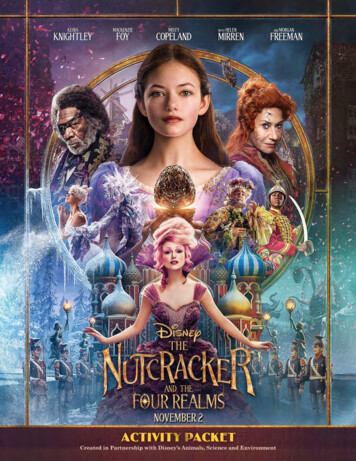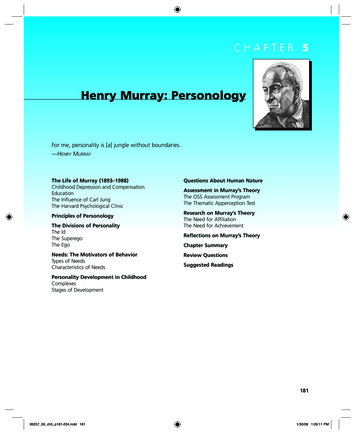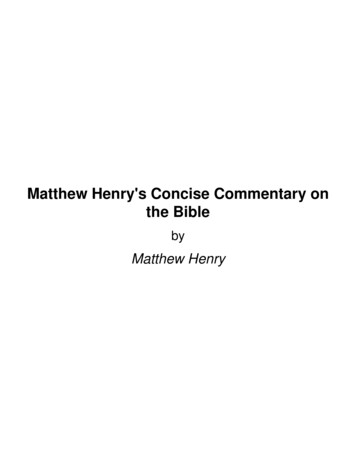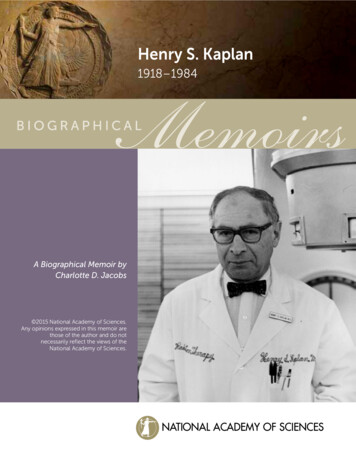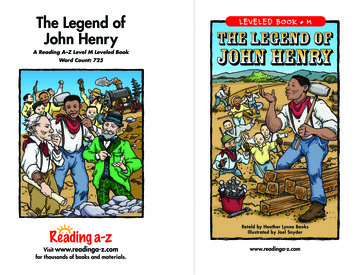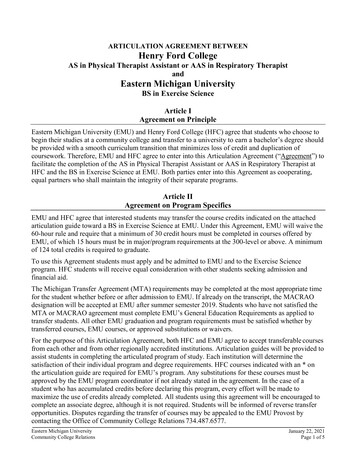
Transcription
IN THE REALMS OFHENRY DARGERA HIGH SCHOOL CURRICULUMfrom theAMERICAN FOLK ART MUSEUMEducation Department2 Lincoln SquareNew York, NY 10023212. 265. 1040, ext. rgRevised edition, 2011First published in 2002
CURRICULUM DEVELOPMENT TEAMBrooke Davis AndersonFormer Director and Curator of The Contemporary Center and the Henry Darger Study CenterAmerican Folk Art MuseumDorothy BauhoffArts EducatorVanguard High School, New YorkLee KoganCurator EmeritaAmerican Folk Art MuseumRoy MartinESL EducatorAlternative High School Division, New YorkEd McCarthyEnglish TeacherLaGuardia High School, New YorkGreg NockmanArt TeacherLaGuardia High School, New YorkDiana SchlesingerFormer Director of EducationAmerican Folk Art MuseumEDITORIAL STAFFTanya HeinrichDirector of PublicationsAmerican Folk Art MuseumMareike GroverFormer Managing EditorAmerican Folk Art Museum2
CONTENTSVisiting the American Folk Art Museum4Considerations for Educators6Resources7Henry Darger (1892–1973)Darger’s Life and Legacy10Darger’s Writings11Darger’s Visual World12The Significance of Darger’s Archive13Lesson PlansThe Artist and Society15Lesson Plan I16Chart: What Constitutes Art?17Lesson Plan II18Lesson Plan III20Diagram: Making a Book21Children and Adults22Lesson Plan I23Poem: “We Sigh for the Child Slaves”24Lesson Plan II25Forces of Nature26Lesson Plan I27Lesson Plan II28Excerpt: Darger’s Weather Journal29Heroes, Heroines, and Gender30Lesson Plan I31Excerpt: “Why Little Girls Are Heroines of This Story”33Lesson Plan II34Lesson Plan III35Good and Evil36Lesson Plan I37Lesson Plan II39Fantasy and Reality41Lesson Plan I43Lesson Plan II453
VISITING THE AMERICAN FOLK ART MUSEUMThank you for choosing the American Folk Art Museum for your students. The museum offers arange of discussion-based gallery and artmaking programs for students, including single visits andmultisession museum-school partnerships. For more information on current programs for students,please call 212. 265. 1040, ext. 381, or e-mail grouptours@folkartmuseum.org. For information abouteducator programs, please call 212. 265. 1040, ext. 119. Information about all programs, which areoffered Mondays through Fridays, anytime between 10:30 AM and 4 PM, can also be found on themuseum’s website, www.folkartmuseum.org.Planning Your VisitThe museum is a contracted vendor with the New York City Department of Education (vendornumber: MUS005000, contract number: QR1640A). To make your reservation, call 212. 265. 1040,ext. 381, or e-mail grouptours@folkartmuseum.org. Reservations must be made at least one month inadvance. Groups must have one adult chaperone per every ten students. Chaperones and teachers are responsible for supervising groups. The museum does not allow self-guided groups. All groups must have a reservation with amuseum guide. Tours in select languages, including American Sign Language and visual descriptions, areavailable. Additional lead time may be necessary to schedule such a tour.To discuss options for multisession museum-school partnerships, which include classroom andmuseum visits and can be tailored to your curricular needs, please call 212. 265. 1040, ext. 381.Payment and CancellationFor full payment and booking information, please visit www.folkartmuseum.org.AccessibilityThe museum is fully accessible and welcomes visitors and groups with special needs. American SignLanguage interpretation for gallery tours and auditorium programs is available by request with onemonth advance notice. Gallery tours with verbal imaging and tours of touch objects from themuseum’s collection are available by request with one-month advance notice. Two wheelchairs areavailable for use during your visit. For details, please contact the education department at 212. 265.1040, ext. 381.4
LunchThe museum does not have a place for groups to enjoy bag lunches. There is a public outdoor parkwith benches directly across from the museum.Getting HereThe American Folk Art Museum is located at 2 Lincoln Square (Columbus Avenue at 66th Street). Buses may drop off school groups in front of the museum. There is no parking lot. Subway: 1 to 66 Street—Lincoln Center/Broadway Bus: M1, M2, M3, M4, M5, M6, M7The museum’s branch gallery is located at 2 Lincoln Square, Columbus Avenue at 66th Street. Subway: 1 to 66 Street/Lincoln Center Bus: M5, M7, M11, M20, M66, M1045
CONSIDERATIONS FOR EDUCATORSHenry Darger’s epic The Story of the Vivian Girls, in What is Known as the Realms of the Unreal, of the GlandecoAngelinnian War Storm, Caused by the Child Slave Rebellion (popularly known as In the Realms of the Unreal)conjures a world that, at times, uses imagery both provocative and disturbing to the viewer. Itsheroines, the brave Vivian Girls, fight the evil Glandelinians to free child slaves who endure variousforms of torment. As we know virtually nothing about Darger’s motivation, scholars and critics areleft to speculate about his fascinations and obsessions. It is not surprising that some have focused onthe more sensational aspects of his work.Educators, such as the high school teachers who helped to create this curriculum, may welcomethe opportunity to open a discussion with students about the important and difficult issues thatyoung people face. Though set in a fantasy world, In the Realms of the Unreal suggests a broad range oftopics, including gender, violence, exploitation, and heroism. Students may see an immediateconnection to the heroes and villains that inhabit comics and cartoons.This curriculum may be used as a guide to examine Darger’s art not only as a remarkable bodyof work but as a vehicle for a dialogue between students and teachers on some of the morechallenging topics of our time.6
RESOURCESBooksAnderson, Brooke Davis. Darger: The Henry Darger Collection at the American Folk Art Museum. New York:American Folk Art Museum in association with Harry N. Abrams, 2001.Bonesteel, Michael, ed. Henry Darger: Art and Selected Writings. New York: Rizzoli, 2000.Jablonski, Joseph. “Henry J. Darger: The Homer of the Mad.” In Ron Sakolsky, ed., Surrealist Subversions:Rants, Writings & Images by the Surrealist Movement in the United States. Brooklyn, N.Y.: Autonomedia,2002.Koide, Yukiko, and Kyoichi Tsuzuki, eds. Henry Darger’s Room: 851 Webster. Tokyo: Imperial Press, 2007.MacGregor, John M. Henry Darger: In the Realms of the Unreal. New York: Delano Greenidge Editions, 2002.Prokopoff, Stephen. Henry Darger: The Unreality of Being. Iowa City: University of Iowa Museum of Art,1996.Articles and ReviewsAllen, Stewart Lee. “The Selling of Henry Darger.” San Francisco Bay Guardian, September 9, 1998.Anderson, Brooke Davis. “The Henry Darger Collection at the American Folk Art Museum.” Folk Art 26,no. 4 (winter 2001/2002): 60–68.Cotter, Holland. “A Life’s Work in Word and Image, Secret until Death.” Review of “Henry Darger: TheUnreality of Being,” Museum of American Folk Art, New York/University of Iowa Museum of Art.New York Times, January 24, 1997.DeCarlo, Tessa. “The Bizarre Visions of a Reclusive Master.” New York Times, January 12, 1997.MacGregor, John. “Henry Darger: Art by Adoption.” Raw Vision 13 (winter 1995/1996): 26–35.MacFarquhar, Larissa. “Thank Heaven for Little Girls: The Lubricious Fantasies of Henry Darger.”Review of “Henry Darger: The Unreality of Being,” Museum of American Folk Art, NewYork/University of Iowa Museum of Art. Slate, February 13, 1997. http://www.slate.com/id/2911(accessed January 24, 2008).Morris, Randall. “Good vs. Evil in the World of Henry Darger.” The Clarion 11, no. 4 (fall 1986): 30–35.Polanski, G. Jurek. “Henry Darger: Realms of the Unreal.” Review of the exhibition at Carl HammerGallery, Chicago. ArtScope.net, October shtml (accessed January 24, 2008).Prokopoff, Stephen. “Henry Darger—The Unreality of Being: On Preparing, Organizing, and Mountinga Darger Exhibition.” Folk Art 21, no. 4 (winter 1996/1997): 46–53.Shaw, Lytle. “The Moral Storm: Henry Darger’s Book of Weather Reports.” Cabinet 3 (summer ger.php (accessed January 24, 2008).Vine, Richard. “Thank Heaven for Little Girls.” Art in America 86, no. 1 (January 1998): 72–79.7
FilmYu, Jessica. In the Realms of the Unreal: The Mystery of Henry Darger. DVD. New York: Wellspring Media,2005.WebsitesAmerican Folk Art Museum:http://www.folkartmuseum.orgPublic Broadcasting Service, “P.O.V.: In the Realms of the lm of the Unreal: A Page about Henry Darger”:http://www.henrydarger.info8
HENRY DARGER(1892–1973)9
DARGER’S LIFE AND LEGACYHenry Darger was born in Chicago in 1892. When he was nearly 4, his mother died of an infectionincurred after she had given birth to a baby girl who was then given up for adoption. Darger livedwith his father, an impoverished tailor, until 1900, when he was placed in a Catholic institution foryoung boys, the Mission of Our Lady of Mercy. He attended public school during this period and wasapparently highly intelligent, showing a particular interest in the Civil War. After evincing signs ofbehavioral problems and the recommendation of several medical evaluations, however, he was sentto live in an asylum for “feeble-minded” children in Lincoln, Illinois. The institution housed fifteenhundred children, many of whom were severely developmentally disabled, and there is no doubt thatDarger received only a rudimentary education during the years he lived there. After his father died in1905, Darger made several attempts to escape from the asylum; in 1909, at age 17, he succeeded. Hereturned to Chicago, where he lived for the rest of his life, working more than fifty hours a week as adishwasher, bandage roller, and janitor for local hospitals. He led a solitary life and attended massseveral times each day at a Catholic church near his home. In 1930, he rented a large second-floorroom on Chicago’s North Side, which he inhabited until the age of 80, when he became too weak toclimb the stairs and moved to a home for the elderly run by the Little Sisters of the Poor—coincidentally the same mission where his father had spent his final years seven decades earlier.Within six months, on April 13, 1973, Henry Darger died at the age of 81.Shortly after Darger had moved out of his room, his landlords, Nathan and Kiyoko Lerner,discovered hundreds of paintings, found images, and hand-bound volumes of Darger’s literary workamong the clutter he had accumulated over the years. Nathan Lerner, an artist himself, recognizedthe merit of the works and took charge of the estate. Not long after its discovery, Darger’s workgained a unique stature among the world of “outsider art,” though some scholars have argued that ittranscends all categorization.The American Folk Art Museum today owns the largest public collection of works by HenryDarger in the United States. The museum’s holdings include more than two dozen paintings, thecomplete manuscripts of all of Darger’s books, and thousands of sketches, tracings, maps, and sourcematerial. In 2001, the institution founded the Henry Darger Study Center, which promotes andfacilitates scholarly research.10
DARGER’S WRITINGSThe magnitude of Henry Darger’s writings leaves one spellbound. They include a six-volume weatherjournal kept daily for ten years (1957–1967); several personal diaries; The History of My Life, anautobiography of more than five thousand pages; and Further Adventures In Chicago: Crazy House, asequel to The Story of the Vivian Girls, in what is Known as the Realms of the Unreal, of the Glandeco-AngelinneanWar Storm, Caused by the Child Slave Rebellion, the artist’s masterful, illustrated epic about another worldtorn apart by war.Darger began to work on In the Realms of the Unreal when he was about 19 years old. Writing inlonghand on legal-size paper first, he then typed the entire epic and began illustrating it. When itwas completed, after decades of work, the typewritten manuscript was 15,145 pages long andcomprised thirteen volumes. Hundreds of large, scroll-like paintings bound into three huge volumesaccompany the narrative.In the Realms of the Unreal is the tale of seven little girls—the Vivian Girls—who set out to rescueabducted children who have been enslaved by the adult Glandelinians. The heroes in this tale arealways the children, the villains typically adults. This story of war and peace, of good versus evil,loosely parallels many of the events of the American Civil War. Darger was a Civil War enthusiast,and he chronicled the flags, maps, and officers in separate journals. In his version of conflict, theenslaved people are white children who usually appear unclothed—Darger poignantly captures thepowerlessness of any enslaved peoples by depicting them as young, innocent, and naked. Thenakedness of the children also exposes their mixed gender, which is a compelling aspect of theartist’s imagery, open to many interpretations.11
DARGER’S VISUAL WORLDHenry Darger’s artistic creation is essentially literary in conception. His paintings, originally bound intovolumes, are illustrations for his epics. Darger created these works on paper over a period of severaldecades. (The work remains undated, and scholars are still uncertain about the length and dates ofDarger’s artistic career.) As he matured into a facile painter and confident colorist, his paintings grew inscale—his sophisticated compositions are often more than nine feet in length. Further, the majority ofhis works is double-sided, and each painting possesses an overwhelming individual presence. Darger’sability to create images of different scale, as well as the extended, panoramic format of pieced paper hedeveloped, probably contributed to the growing complexity and density of his visual works.While he was a capable draftsman who expressed his true talent through color, composition,content, and sheer scale, Darger was also a willful draftsman. In other words, he experimented withvarious techniques to get the effect he wanted. In order to achieve his aesthetic vision, Darger createdinventive techniques involving collage and appropriation from popular media. If he could notmaster the freehand rendering of the human figure, he would trace images from magazines, comicbooks, and other print sources he collected. Many paintings show carbon residue left from tracingthe figures onto the newsprint he typically used. Darger repeated favorite images over and over,sometimes even in the same painting. He would also visit his corner drugstore to have a favored posefrom a popular-media source photographically reproduced and resized. In this manner, he created alibrary of numerous images stored in brown drugstore envelopes and labeled according to theirintended uses. Darger freely and unapologetically appropriated images, and if all else failed, hesimply cut and paste reproductions directly onto his watercolor paintings, creating a collage.It is possible to discern three stages in Darger’s artistic development. The earliest paintings areblunt and forceful and favor strong contrasts and rich, dark coloration. These works, such as themilitary portraits and Blengins, are usually composed on single sheets of standard-size paper and arepainted only on one side. There is a heavy reliance on collage elements, and figures are painteddirectly over printed sources or traced. Many of the works include lengthy textual passages anddescriptions similar in format to newspaper captions.As Darger’s art continued to evolve, his renderings grew in compositional complexity and skill,marking a second phase in his artistic development. Single and group portraits gave way to scenes ofmultiple figures set in landscapes or interior settings, with an emphasis on narrative action. A simplebut functional perspective was formulated, strengthened by an overall intensity of color. Collagebecame less prevalent, with the artist drawing virtually the entire ensemble of images. It was duringthis period that Darger developed the format of several sheets of paper glued together horizontally,as in a comic strip, to form a narrative sequence. Texts are less extensive than in earlier years butcontinue to define characters and action.In his final artistic phase, Darger turned again to collage. This is evident in sequences in whichhe pasted action cutouts of soldiers from newspaper comics. Darger’s most characteristic deviceemerged during this phase: the tracing of images of his principal protagonists—children—fromcoloring books and other sources and manipulating the size photographically to fit the scale of thepainting. A singular innovation is the intrusion of one or more oversized images into the composition.12
THE SIGNIFICANCE OF DARGER’S ARCHIVEHenry Darger’s vast writings and many paintings are supported by his archive, which is now housedin the American Folk Art Museum’s collection. The archive includes the artist’s personal collection ofbooks and clippings from newspapers, magazines, comics, cartoons, and coloring books—the fullbreadth of resource material for his paintings and visual output. The items feature subject mattercommon to many of Darger’s works: girls, clouds, landscapes, weather, war, disasters, and plants.Reflecting the artist’s obsessive nature, there are hundreds and hundreds of clippings featuring thesame subject, often the exact same image in many versions and in multiples. The archive alsoincludes more than a hundred negatives and photo enlargements, which further illustrate Darger’screative process. Finally, there are more than five hundred sketches and studies—often called“tracings”—in ink and pencil. Ranging in size from a few inches square to 20 24" and executed ontracing, typing, wax, and drawing paper, these studies correct the commonly held view that Dargerwas not an able draftsman. Indeed, the delicate and sensitive studies are a testament both to his skillwith the pencil and perhaps to his own doubt in his ability. Darger’s brilliance as an artist restspartly in his talent for making his drawings much more than tracings through his complex processand sure hand.The myriad clippings in Darger’s archive point out how his paintings reflect our culture, or atleast elements of it. American popular media is evident everywhere: The once mysterious Blengins ofDarger’s invention, for instance, have predecessors in an ice-cream ad showing a winged troll stirringa vat of cream and in a phallic-winged creature from the comic Mandrake the Magician. His use of largeflowers and palm trees in lovely landscapes also echoes numerous advertisements in magazines andnewspapers.The archive is important for another reason. So often the work of the self-taught artist is seen asa “happy accident” or an unexplainable occurrence having no roots or foundation in culture, time,and place. The archive solidly reveals how Darger engaged in a creative process and made deliberateaesthetic decisions, and demonstrates that this twentieth-century self-taught artist was clearly rootedin the American experience. While Darger worked in isolation and kept his project private, he was inno way cut off from the communal experience, whether that experience was religious, occupational,emotional, political, or some combination of these. The contents of the archive prove that he wasengaged in the life of his church and place of employment, that he had personal relationships (albeitfew), and that he was aware of and interested in current events such as the world wars and inhistorical moments such as the Civil War.13
LESSON PLANS14
THE ARTIST AND SOCIETYUnit ObjectivesStudents will examine the notions of “artist” and “artistic production” and investigate the interactionsbetween an artist and his or her social environment; learn to use some of the vocabulary of art criticism to raise and respond to questions concerningthe role of the artist in society and the nature of the creative process.The lesson plans in this unit relate to the followingNew York State Learning Standards:Learning Standards for the Arts Standard 3: Students will respond critically to a variety of works in the arts, connecting theindividual work to other works and to other aspects of human endeavor and thought. Standard 4: Students will develop an understanding of the personal and cultural forces thatshape artistic communication and how the arts in turn shape the diverse cultures of past andpresent society.Learning Standards for English Language Arts Standard 1: Students will read, write, listen, and speak for information and understanding. Standard 3: Students will read, write, listen, and speak for critical analysis and evaluation.IntroductionAn extensive body of writing—words, rhymes, and journals—exists outside the realm of publishedworks. Likewise, a wealth of visual art is being created outside the walls of professional studios andnot shown in galleries and museums. The work of Henry Darger, created in solitude yet rich inimagery and derived in part from the popular culture of his time, will serve as motivation for thelessons in this unit, which address definitions of the terms art and artist and issues revolving aroundart criticism, while raising questions concerning the relationship between artist and society. Creativehands-on projects will be part of two of the lessons.Related queNarrativeIconographyOutsider15
THE ARTIST AND SOCIETY—LESSON PLAN IAims/ObjectivesStudents will investigate the idea of artistic production in isolation from society; acquire information about the life and work of Henry Darger.Materials Reproductions of the two color plates illustrating Darger’s creative process Reproductions of 175 At Jennie Richee. Everything is allright though storm continues. Copies of the chart “What Constitutes Art?” (page 17)Do Now/MotivationDefine, in writing, the term artist.ProcedureUse a few of the student responses to the “Do Now” question as a starting point for discussion.Distribute, or write on the board, the chart “What Constitutes Art?” Have the students workindividually or in groups and lead them in a discussion of their ideas about the artworks or eventslisted on the chart. Do they constitute “art”? How does society define these works and events? Showreproductions of the images listed under “Materials” (see above) as motivation for a discussion ofDarger’s work, life, and use of popular-culture imagery.Summary/class discussion: How do we define the term artist?Assessment/HomeworkAsk the students to clarify, in writing, their definition of the term artist, considering why, or why not,they believe that Henry Darger was an artist.16
WHAT CONSTITUTES ART?Artw or k orart s ev entWho cr eated it ?What i s itspur po se?Who i s theint ended a udi ence?Mural on abuildingStained-glasswindowSanto figure ona home altarDrawing in asketchbookWriting in ajournalRock concert17
THE ARTIST AND SOCIETY—LESSON PLAN IIAims/ObjectivesStudents will investigate the interaction of popular culture and artistic production by examining the use ofimages from popular media in the work of Henry Darger; create an original work of art using materials and processes that mirror the ones Dargeremployed.Materials Reproductions of various Darger paintings Clippings from magazines (if possible, use images that reflect the identity and tastes—music,fashion, etc.—of your students) Paper or illustration boards (at least 8 10") Scissors Glue or glue sticksDo Now/Motivation Where do you think Darger found his visual inspiration? Where did he find the pictures that helped him create his artworks?ProcedureFor a few minutes, have the students write brief answers to the “Do Now” questions. Ask volunteersto share their answers. Discuss the images used in popular media in Darger’s time. Some questions toguide the discussion: Why might an artist borrow an image from an existing illustration or photo? How do borrowed images give Darger’s work a familiar look? Or do the borrowed images createa different effect (for example, an element of surprise or displacement)? Use some of Darger’sworks to support your answer. Darger’s use of images from popular media of his time gives his paintings a look that ties it to aspecific time period and identifiable aesthetic, taste, or way of viewing the world. Where did helocate images of children? How are these images different from those we see in the media today? You may notice that all the girls are white and many of them are blond. What does this sayabout the media of Darger’s time? We are going to create artwork using images from contemporary popular culture. How do youexpect these artworks will differ from Darger’s work?Activity: Using magazine clippings, make a collage that re-creates Darger’s narrative (or your ownstory) in the visual language of contemporary American life. Use overlapping images and add drawnbackground elements or details.18
Summary/class discussion: How did Darger use popular (found) images in his work?Assessment/HomeworkHang collages for class review. Some questions to guide the discussion: How does the collage reflect contemporary American culture? What personal vision, message, or story does the collage convey? How does the popular culture of our time influence the way you tell a story or communicate anidea?The students may respond to any of these questions for homework.19
THE ARTIST AND SOCIETY—LESSON PLAN IIIAim/ObjectiveStudents will create personal journals or sketchbooks.Materials Composition books or spiral notebooks Construction paper or oak tag Colored masking tape Narrow ribbon (24" per book) Glue or glue sticks Diagram for making a book (page 21)Do Now/MotivationWhat are some of the differences between writing, or drawing, in a personal journal or sketchbookand writing, or creating a visual work of art, that will be viewed by other people?ProcedureFor a few minutes, have the students write a brief answer to the “Do Now” question. Ask volunteersto share their answers. Topics may include privacy, spontaneity, freedom of expression, and lack ofconcern over criticism. Ask the students if any of them keep journals, diaries, or sketchbooks.Construct personal journals: Instruct the students to cut paper to fit the inside and outside covers of notebooks, and to cutribbons to 12-inch length. Have the students open their books. Using glue or glue sticks, each student should affix one endof the ribbon to the left edge of the cover, about midway down its length. Only about one-half toone inch of ribbon will be glued down; the rest will extend outside the book. This will become atie to secure the book for privacy. Now have each student glue down a piece of paper to cover the end of the ribbon and line theinside cover. Repeat the process on the back cover. Have each student close their book and glue down papers to cover the outside cover, front andback. Instruct them to use masking tape to create decorative edges; half of the tape will befolded over the front, half over the back.Assessment/HomeworkThe students may use collage or drawing to further personalize their books. The books may be usedfor creative-writing projects, journal writing, sketching, etc.20
21
CHILDREN AND ADULTSUnit ObjectivesStudents will examine the concepts of “children” and “adults” and investigate the interactions of childrenand adults in the work of Henry Darger; look to Darger’s writings and poetry to respond to questions about the roles of children andadults in our society.The lesson plans in this unit relate to the followingNew York State Learning Standards:Learning Standards for the Arts Standard 3: Students will respond critically to a variety of works in the arts, connecting theindividual work to other works and to other aspects of human endeavor and thought. Standard 4: Students will develop an understanding of the personal and cultural forces thatshape artistic communication and how the arts in turn shape the diverse cultures of past andpresent society.Learning Standards for English Language Arts Standard 1: Students will read, write, listen, and speak for information and understanding. Standard 2: Students will read, write, listen, and speak for literary response and expression. Standard 3: Students will read, write, listen, and speak for critical analysis and evaluation.IntroductionThe world Darger created in his writings and visual art is filled with children—some of whom arevictimized, such as the child slaves held by the evil Glandelinians, and others who are heroines, suchas the seven Vivian Girls who come to the child slaves’ rescue. Scholars have looked for connectionsbetween Darger’s subject matter and his personal history; when Darger was nearly 4 years old, hismother died after having given birth to a baby girl, who was then given up for adoption and whomDarger presumably never saw. Whatever the reasons, it is clear that in Darger’s imagined worldchildren play a central role. In his autobiography, The History of My Life, he writes, “Unlike mostchildren I hated to see the day come when I will be grown-up. I never wanted to. I wished to be youngalways.” In this unit, students will consider the unconventional roles that children and adults play inDarger’s written and visual works and look for correlations with their own perceptions of age-basedroles.Related VocabularyLimitationPortrayPineSlavery22Symbolic
CHILDREN AND ADULTS—LESSON PLAN IAim/ObjectiveStudents will consider how Henry Darger portrays the struggle of children in his work.Materials Copies of Darger’s poem “We Sigh for the Child Slaves” (page 24) Reproductions of At 5 Norma Catherine. but are retaken.Do Now/Motivation As a young person, what, if anything, holds you back? What or who places limits on you?ProcedureFor a few minutes, have the students write brief answers to the “Do Now” questions. Ask volunteersto sha
6 CONSIDERATIONS FOR EDUCATORS Henry Darger’s epic The Story of the Vivian Girls, in What is Known as the Realms of the Unreal, of the Glandeco- Angelinnian War Storm, Caused by the Child Slave Rebellion (popularly known as In the Realms of the Unreal) conjures a world that, at times, us
